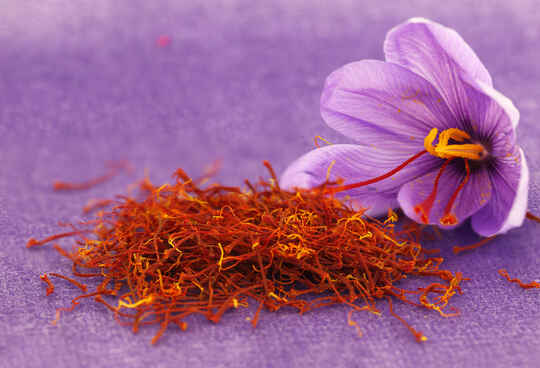How To Harvest Saffron Spice Successfully

Saffron, often referred to as “red gold,” is a spice that has dazzled the world with its amazing flavor and vibrant color. Harvesting your own saffron spice is a journey filled with tradition and a deep connection to nature. In this article, we’ll explore the delicate process of harvesting, step by step, from the saffron flower to the precious saffron threads.
Meet The Saffron Crocus
At the heart of saffron harvesting is the saffron crocus (Crocus sativus), a small but magnificent flower that blooms in the fall, typically from October to November. This unassuming flower holds within its petals the coveted saffron threads, which consist of three parts: the red threads (stigma), the yellow center (stamen), and the purple petals.

The Essence Of Saffron Parts
Before diving into the art of saffron harvesting, it’s essential to understand the value of each part of the saffron crocus. The stigmas, the bright red threads, are the saffron spice itself. The stamens and petals, while not as precious as the stigmas, also have value and can be used as a dye. Depending on your preference and intention, you may choose to dry all parts or focus on the stigmas and stamens for their higher value.
Related: How To Get Started Growing Saffron
Picking The Perfect Moment
Timing is crucial when it comes to saffron harvesting. The ideal moment to pick saffron flowers is when they are fully elongated and just beginning to open. This stage ensures that the stigmas have developed to their full length. Picking them too early when the flowers are still closed or too late when they have wilted can affect the quality and quantity of your saffron threads.
Embracing The Morning Harvest
The morning sun is your ally in the saffron harvesting process. In hot climates, it’s preferable to pick saffron flowers before the sun’s rays become intense. This practice not only keeps the harvesters comfortable but also preserves the quality of the flowers and, consequently, the stigmas. However, in regions with dew, rain, or even snow during the saffron blooming season, waiting a few hours until the flowers are fully dry and thawed is recommended. The sun, though essential, can also degrade the flower and its stigmas.
Gentle Handling For A Golden Yield
To harvest saffron, use your thumbnail and index finger to cut the entire flower at its base, ensuring you remove it entirely. Only select clean, fresh flowers, discarding any that are covered with dirt or mold. Handle the flowers with care to prevent crushing or damage. It’s essential not to pick the leaves, as they continue to grow throughout the winter and contribute to next year’s corms.
Preserving The Harvest
After harvesting, place the saffron flowers on a clean tray or in a wide basket. Avoid stacking them too deeply, as the weight of the flowers on top may damage those beneath. Condensation may also form, which is not suitable for saffron. To protect your harvest, keep the flowers covered to prevent prolonged exposure to the sun.

The Swift Separation
To maintain saffron’s quality, it’s essential to separate the stigmas from the petals and stamens as soon as possible after harvesting. When the flowers begin to wilt, separating the stigmas becomes more challenging. Most people prefer to bring the flowers inside for separation, but some opt to pick the stigmas in the field with tweezers while leaving the other parts behind. The choice depends on your preference and efficiency. If you can’t process the flowers immediately, spread them on a paper towel on a tray and store them in the refrigerator to preserve their freshness.
A Journey Of Discovery
Saffron harvesting is a blend of tradition, patience, and reverence for nature’s gifts. As you embark on the journey of harvesting your own saffron spice, you’ll find yourself connected to centuries of tradition. Each crimson thread you pluck represents not only saffron’s value but also the care and dedication you’ve invested in capturing nature’s most valuable spice.
Join The Discussion
Are you growing your own saffron spice this year? Shop Now
Share your experience with your community here in the comments below!
We hope that our guide inspired you!
This story contains product affiliate links. We may receive a commission if you make a purchase after clicking on one of these links.
Chad Philipp
Connect with Chad and Tara Philipp of She’s Rooted Home Saffron Farm, located in the Southern California Mojave Desert. She’s Rooted Home is one of the largest saffron farms in the USA.
Recognizing their Southern California desert homestead had a similar climate to Iran, the world's largest producer of saffron, Chad and Tara planted over 55K corms and harvested well over 100 grams of saffron their first year. Saffron corms take up very little space and don’t require much water or nutrition. It’s an easy plant to care for, making it a perfect addition to the kitchen garden. Chad and Tara want to educate homemakers on cooking from scratch, including the uses + benefits of herbs and spices. Helping us regain confidence & understanding of herbs & spices in the home kitchen.







I’ve been growing crocus for years and up until now have been harvesting the stigmas with tweezers and leaving the flower attached. This year I harvested the entire flower and brought them inside to finish the harvest. The flowers smell so good. Is there any reason I could not eat or make a tea with the petals?
It’s important to keep the stamens and stigmas separate, as the yellow stamens really should not be ingested. I’ve been growing saffron crocus for years, and find it easiest to simply pluck the red stigmas out of the flowers, leaving the blossoms attached to the stems. Thoroughly drying the fragile stigmas is essential, then store them in an airtight container away from the light.
Thank you for this tip! It is greatly appreciated!